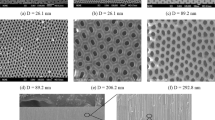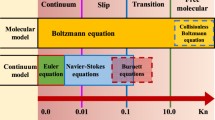Abstract
Due to abundant micro-/nanoscale pores and throats, gas flow behavior in tight/shale reservoirs always showed strongly nonlinearity which deviated from the conventional Darcy’s law. As micro-/nanoscale flow experiment was a direct approach to investigate flow characteristic, in this paper, we improved the microscale flow experiment which was widely used in the field of MEMS to adapt for high-pressure conditions. By using microtubes with inner diameter ranging from 0.2 to 5 µm, we investigated the low velocity nonlinear flow characteristic of nitrogen especially under high pressures. In addition, we used experimental results to evaluate the accuracy of three typical flow models which were widely used in gas apparent permeability determination. The results indicated that gas flow behavior in microtube under high outlet pressures was opposite to that under low outlet pressures. When the outlet pressure was low, slippage effect had a great influence on the flow. With the increase in the pressure gradient, the slippage effect became weakened. And the slippage effect would disappear with the increase in the outlet pressure as well as tube inner diameter. The minimum outlet pressure for eliminating the slippage effect of nitrogen for the 0.2 µm tube was 10 MPa which decreased with the tube diameter. However, under high outlet pressures, the flow resistance increased in the region with smaller pressure gradients and varied inversely with the pressure gradient. This phenomenon became more significant with the increase in the outlet pressure and the decrease in the tube inner diameter. From the comparison of 3 typical flow models against our experimental results, we can find different models will match with the data measured under different mean pressures. And the applicability of those models also varied with the tube inner diameter. Thus, it was crucial to select an appropriate model according to different reservoir conditions.







Similar content being viewed by others
References
An WQ et al (2016) The deviation of gas permeability and classical theory in tight reservoir cores with high pressure. J Nat Gas Sci Eng30:331–337
An WQ, Yue XA, Feng XG, Fu J, Fang X, Zou JR, Fang W (2017) Non-Klinkenberg slippage phenomenon at high pressure for tight core floods using a novel high pressure gas permeability measurement system. J Petrol Sci Eng 156:62–66
Beskok A, Karniadakis GE (1999) Report: a model for flows in channels, pipes, and ducts at micro and nano scales. Microscale Thermophys Eng3(1):43–77
Beskok A, Karniadakis G (2002) Microflows: fundamentals and simulation. Springer, New York, p B76
Bhattacharya DK, Lie GC (1991) Nonequilibrium gas flow in the transition regime: a molecular-dynamics study. Phys Rev A43(43):761–767
Bird GA (2003) Molecular gas dynamics and the direct simulation of gas flows. Clarendon Press, Oxford
Civan F (2010) Effective Correlation of apparent gas permeability in tight porous media. Transp Porous Med82(2):375–384
Civan F (2013) Modeling gas flow through hydraulically-fractured shale-gas reservoirs involving molecular-to-inertial transport regimes and threshold-pressure gradient. In: SPE annual technical conference and exhibition society of petroleum engineers
Cui H, Silberli Z, Zhu S (2004) Flow characteristics of liquids in microtubes driven by a high pressure. Phys Fluids16(5):1803–1810
Curtis ME et al (2012) Microstructural investigation of gas shales in two and three dimensions using nanometer-scale resolution imaging. Aapg Bull96(4):665–677
Ertekin GR, King, Schwerer FC (1986) Dynamic gas slippage: a unique dual-mechanism approach to the flow of gas in tight formations. Spe Format Evaluat1(1):43–52
Florence F et al (2007) Improved permeability prediction relations for low permeability sands. In: Rocky mountain oil and gas technology symposium
Geng L et al (2016) A diffusion–viscous flow model for simulating shale gas transport in nano-pores. Fuel181:887–894
Guo C et al (2015) Study on gas flow through nano pores of shale gas reservoirs. Fuel143:107–117
Hornyak GL, Tibbals HF, Dutta J, Moore JJ (2008) Introduction to nanoscience and nanotechnology. CRC Press, Boca Raton
Kawata Y, Fujita K (2001) Some predictions of possible unconventional hydrocarbons availability until 2100. In: SPE Asia Pacific Oil and Gas Conference and Exhibition. Society of Petroleum Engineers
Kohl MJ et al (2005) An experimental investigation of microchannel flow with internal pressure measurements. Int J Heat Mass Transf48(8):1518–1533
Lemmon EW, Huber ML, Mclinden MO (2010) NIST standard reference database 23: reference fluid thermodynamic and transport properties-REFPROP, Version 9.1. NIST NSRDS
Li S, Dong M, Li Z (2009) Measurement and revised interpretation of gas flow behavior in tight reservoir cores. J Petrol Sci Eng65(1):81–88
Liu Q, Shen P, Yang P (2002) Pore scale network modelling of gas slippage in tight porous media. In: Fluid flow and transport in porous media mathematical and numerical treatment, p 367–375
Loucks RG et al (2015) Morphology, genesis, and distribution of nanometer-scale pores in siliceous mudstones of the Mississippian Barnett shale. J Sediment Res79(12):848–861
Marino L (2009) Experiments on rarefied gas flows through tubes. Microfluid Nanofluid6(1):109–119
Mason EA, Malinauskas AP (1983) Gas transport in porous media: the dusty-gas model. Elsevier, Amsterdam
Morini GL, Lorenzini M, Salvigni S (2006) Friction characteristics of compressible gas flows in microtubes. Exp Thermal Fluid Sci30(8):733–744
Roy S et al (2003) Modeling gas flow through microchannels and nanopores. J Appl Phys93(8):4870–4879
Sakhaee-Pour A, Bryant S (2012) Gas permeability of shale. Spe Reser Evaluat Eng15(4):401–409
Salam DD (2015) Novel analysis to determine gas permeability. In: Spe technical conference and exhibition
Shahri MR, Aguilera R, Kantzas A (2012) A new unified diffusion-viscous flow model based on pore level studies of tight gas formations. Spe J18(1):38–49
Shaoliang XU, Yue XA, Hou JR (2007) Experimental investigation on flow characteristics of deionized water in microtubes. Chin Sci Bull52(6):849–854
Shi J et al (2013) Diffusion and flow mechanisms of shale gas through matrix pores and gas production forecasting
Song W et al (2016) Apparent gas permeability in an organic-rich shale reservoir. Fuel181:973–984
Steinke ME, Kandlikar SG (2005) Single-phase liquid friction factors in microchannels. Int J Therm Sci45(11):1073–1083
Sun H et al (2015) Understanding shale gas flow behavior using numerical simulation. Spe J20(1):142–154
Tian W et al (2018) The threshold pressure gradient effect in the tight sandstone gas reservoirs with high water saturation. Fuel226:221–229
Tokumasu T, Matsumoto Y (1999) Dynamic molecular collision (DMC) model for rarefied gas flow simulations by the DSMC method. Phys Fluids11(7):1907–1920
Wang Z, Krupnick A (2013) A retrospective review of shale gas development in the United States: what led to the boom?Soc Sci Electron Publ (2013) 4(1)
Wang M, Li Z (2003) Nonideal gas flow and heat transfer in micro- and nanochannels using the direct simulation Monte Carlo method. Phys Rev E Stat Nonlinear Soft Mater Phys68(4 Pt 2):046704
Wang FP, Reed RM (2009) Pore networks and fluid flow in gas shales. In: SPE annual technical conference and exhibition, Society of Petroleum Engineers
White FM (2006) Viscous Fluid Flow20(4):548–550
Wu K et al (2014) Apparent permeability for gas flow in shale reservoirs coupling effects of gas diffusion and desorption. In: Unconventional resources technology conference
Wu K, Chen Z, Li X (2015) Real gas transport through nanopores of varying cross-section type and shape in shale gas reservoirs. Chem Eng J281(281):813–825
Wu K et al (2016) A model for multiple transport mechanisms through nanopores of shale gas reservoirs with real gas effect–adsorption-mechanic coupling. Int J Heat Mass Transf93:408–426
Wu K, Chen Z, Li X (2017a) Flow behavior of gas confined in nanoporous shale at high pressure: real gas effect. Fuel205:173–183
Wu J et al (2017b) Experimental study of nonlinear flow in micropores under low pressure gradient. Transp Porous Media119(1):247–265
Yang Z et al (2015) Threshold pressure effect of low permeability tight gas reservoirs in Sulige gas field. Acta Petrol Sin36(3):347–354
Zhang P et al (2015) A multi-flow regimes model for simulating gas transport in shale matrix. Géotech Lett5(July–September):231–235
Ziarani AS, Aguilera R (2012) Knudsen’s permeability correction for tight porous media. Transp Porous Media91(1):239–260
Zou C et al (2012) Types,characteristics,genesis and prospects of conventional and unconventional hydrocarbon accumulations:taking tight oil and tight gas in China as an instance. Acta Petrol Sin33(2):173–187
Acknowledgements
The authors would like to thank the National Natural Science Foundation of China (51334007) and National Science and Technology Major Project of the Ministry of Science and Technology of China (2016ZX05009004-003). The authors are grateful to the editor and two anonymous reviewers for their careful reviews and detailed comments that have significantly improved the quality of the manuscript.
Author information
Authors and Affiliations
Corresponding author
Additional information
Publisher’s Note
Springer Nature remains neutral with regard to jurisdictional claims in published maps and institutional affiliations.
Rights and permissions
About this article
Cite this article
Fang, X., Yue, X., An, W. et al. Experimental study of gas flow characteristics in micro-/nano-pores in tight and shale reservoirs using microtubes under high pressure and low pressure gradients. Microfluid Nanofluid 23, 5 (2019). https://doi.org/10.1007/s10404-018-2175-9
Received:
Accepted:
Published:
DOI: https://doi.org/10.1007/s10404-018-2175-9




